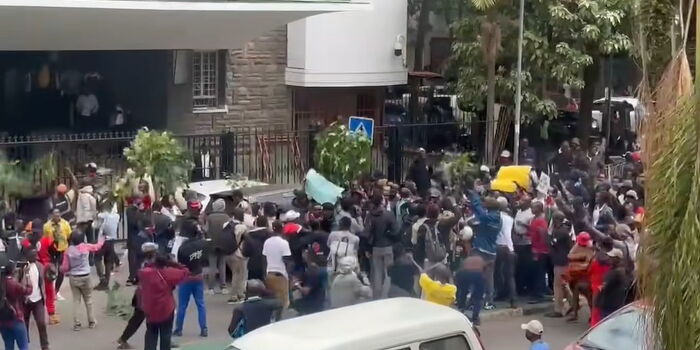On Thursday, June 12, chaos broke out in the heart of Nairobi as hundreds of angry youth flooded the Central Business District (CBD) demanding justice for influencer Albert Ojwang, who died under suspicious circumstances while in police custody.
The protestors also called for the immediate resignation of Deputy Inspector General of Police, Eliud Lagat, accusing him of failing to act on police brutality.
The demonstration disrupted normal activities in the city centre as Kenyans braced for the reading of the 2025/2026 National Budget by Treasury Cabinet Secretary John Mbadi. The tension was high, with key government offices and roads being targeted by the protestors.
The demonstrators moved in large numbers through major city landmarks including City Hall, Jeevanjee Gardens, and the Parliament Buildings.
They also took over critical roads such as Harambee Avenue, in what appeared to be a bold attempt to push past police barriers and enter the secured zone around Parliament.
Police officers responded swiftly, firing tear gas canisters into the crowds to disperse the demonstrators. The scenes turned chaotic, with loud bangs from the tear gas and people running in all directions to avoid the choking fumes.
In addition to tear gas, police employed various crowd-control methods in an effort to suppress the protests.
Some of the protestors were seen wearing outfits in the colours of the Kenyan flag—black, red, green, and white—symbolizing patriotism and unity.
They marched in solidarity, chanting songs and slogans demanding accountability for Ojwang’s death. Their message was clear: they want justice and answers.
Photos and videos reviewed by Newshub.co.ke showed a sea of protestors holding placards with strong messages directed at the government and police leadership.
Many waved twigs, blew whistles, and shouted slogans as they moved through the streets. The signs carried powerful phrases like “Justice for Ojwang,” “End Police Brutality,” and “Resign Lagat Now!”
To prevent more youth from joining the protests, the government deployed heightened security measures on key routes into the city. Along Thika Road, motorists reported unusual delays as police conducted strict inspections on vehicles entering the CBD.
Officers manned roadblocks, checked identification, and interrogated passengers, all in an attempt to limit access to the city centre.
By midday, a heavy police presence had taken over Nairobi’s central streets. Anti-riot officers in full gear were seen standing guard at major intersections, while other units patrolled the roads in police trucks. They were supported by regular officers in an effort to prevent further escalation.
Despite the strong police show of force, the demonstrators remained unshaken. Groups of protestors continued to regroup and march through different parts of the CBD, refusing to be silenced.
The sound of whistles, chants, and the occasional tear gas explosion could be heard from various streets.
At the same time, the government was keen to ensure that the national budget reading proceeded without interruptions.
As Treasury CS John Mbadi prepared to deliver the financial plan from the Treasury building to Parliament, the police worked overtime to clear the streets and secure the route.
Meanwhile, top police leaders, including Inspector General Douglas Kanja and Directorate of Criminal Investigations (DCI) boss Mohamed Amin, were appearing before the National Assembly’s Departmental Committee on Administration and Internal Security.
They were summoned to explain the circumstances surrounding Ojwang’s controversial death and what the police are doing to ensure justice is served.
The protests reflect growing anger among Kenyan youth over police abuse and lack of accountability. As the situation continues to unfold, many are watching closely to see if the government will take concrete action to address the public’s concerns—or if more protests will follow.
Join Gen Z New WhatsApp Channel To Stay Updated On time
https://whatsapp.com/channel/0029VaWT5gSGufImU8R0DO30


